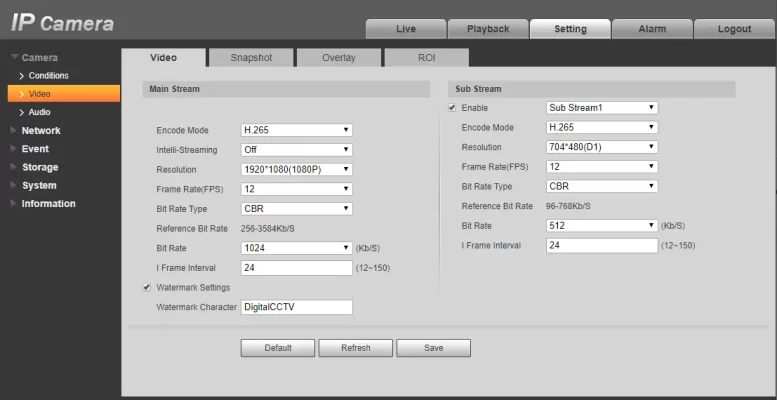What Is The Best Bitrate For Security Camera

This setup guide demonstrates how to configure an IP camera. The screenshots used were taken from an ICRealtime camera, however, the aforementioned settings tin be applied to most brands. Camera brands that will present the settings very similarly are Clearview, Dahua, Hikvision, and Qsee.
Check out our buying guide for business organisation security cameras.
IP Camera: Video Encode Settings
Everyone'southward instict is to plow these settings upwards as high as they go, but less is sometimes more. What we want to focus on is providing a smooth, crystal clear image that uses the to the lowest degree amount of bandwidth possible. The image at the top of the folio is a screenshot of the IP Camera settings I typically use.
Equally you tin run across, the Main Stream and Sub Stream are separated into ii columns. The Main Stram is typically what's used for recording, which makes prototype quality of loftier importance. The substream is most commonly used to view the camera feed over the internet, which makes bandwidth management of greater importance than paradigm quality.
The aggressiveness at which image quality or bandwidth is prioritized is based on the usage and the network environment. For instance, if we have an function with a single IP Camera that records to an SD menu then bandwidth becomes less important. Besides, if we have an office that has 64 cameras recording to an NVR then bandwidth management becomes critical. Near existent life use cases will prevarication somewhere in between.
Keep in heed, that bandwidth usage direct relates to storage consumption. An IP camera outputting 4096 Kb/southward will require four times the storage capacity as an IP camera streaming at 1024 Kb/due south over the same corporeality of time.
Encode Style
My default IP photographic camera encode fashion is H.265.
Always cull the highest level of compression in this guild: H.265, H.264H, H.264, and MJPEG. The only reason to go down a compression level is if there's a compatibility issue. For instance, certain viewing software may not be able to view recorded H.265 footage, in which case defaulting to H.264 may be necessary.
Some 3rd party integrations may merely back up MJPEG streams. In this instance, it's best to exit the Chief Stream at a loftier compression level and to set the third political party device to retrieve the Sub Stream, which in this example should exist set for MJPEG. The MJPEG format should exist avoided unless absolutely necessary.
Resolution
My IP camera default resolution settings is always the highest available, which is usually 1080P (1920 x 1080).
Generally, IP Cameras should be set to the highest available resolution. However, if you can lower the resolution without whatsoever noticable loss in quality (cheque zoom too) then there'southward no reason not to lower it.
For the Sub Stream, resolution may need to be adjusted to fit a preferred aspect ratio of a particular viewer. Almost viewers are designed to be cable with a D1 resolution, which is 704 10 480. This is well-nigh ane/3 MP and adequately shut to a 4:3 aspect ration (16:eleven).
Frame Rate
My default IP camera frame rate is generally 12-fifteen FPS on the Primary Stream and 10-12 on the Sub Stream.
There's almost no reason to use the highest frame rate available. Consider the purpose of your IP cameras and decide if it needs to be cinema quality, and if being cinema quality is worth the bandwidth and storage consumption that comes along with information technology.
The frames per 2d setting will affect how smoothly movement is captured. If the IP Photographic camera is above a greenbacks register, and so a higher frame rate might be necessary to catch fast moving hands. Likewise, if it's an IP camera in a low traffic storage room then a higher frame rate just isn't necessary and I'd adopt to salvage bandwidth and storage.
I notice that a frame rate of 15 FPS is sufficiently polish to capture fast moving hands, and that a frame rate of ten FPS is sufficient depression traffic areas.
If video is too choppy, raise the frame rate by x% until it is smooth. Remember though, it's not cinema.
Scrap Rate
My default bit rate is mostly 40% of the range provided by the camera. For MJPEG strams, I'm generally at 75%.
The Bit Rate setting is straight command over the bandwidth consumption of the IP camera and should be prepare as low as possible without negatively affecting the prototype.
Near IP Cameras will have the current settings into account and then recommend a range for the bit rate. To showtime, gear up your bit charge per unit at the upper 75% mark of the range. Bank check the live view, and run into how the picture looks.
Then, accommodate the bit charge per unit to the 40% mark of this range. See if there's any noticable difference. If there is not, then leave it here. If there is, and so outset trying to detect something in the centre. Generally, IP Camera fleck rates should not go below xl% or above 75%.
If the IP Camera does not offer a suggested range then for a 2MP using H.265 at 15FPS offset at 2048 Kb/southward. Lower to 1024 Kb/southward to see if at that place's a difference. Double these values for a 4MP IP Photographic camera, and add together 50% if using H.264.
Coming Before long: Event Detection and Storage Plans.
Source: https://myeasytek.com/blog/ip-camera-configuration/
Posted by: andradefirsay1991.blogspot.com

0 Response to "What Is The Best Bitrate For Security Camera"
Post a Comment